Alan Cooper , one of my user-centered design gurus, was the first to teach me that often, products that have been inspired by a specific need of a specific group of people end up being broadly successful (the rolling suitcase is a famous example). I’ve always loved this concept.
I love it even more when the niche product that becomes broadly successful was initially designed for people with special needs. (If you have such universal-design-is-good-for-you examples, please send them my way)
A nice example, Snaidero’s Skylab kitchen, is described in a book called Design-driven innovation: Changing the rules of competition by radically innovating what things mean, by Roberto Verganti (this is an interesting and provocative book, and it comes recommended by Don Norman)
This kitchen was created to make it easier for people in wheelchair to move around and access stuff in cabinets and on countertops. The team working on this project spent hours observing wheelchair users using traditional kitchens and thinking about ways to adapt the design to their needs.
For example, they created round countertops that allowed people in wheelchair to move around more easily, and carousel countertop to reach objects on counters and in cabinets (more pictures of Skylab)
It turned out that all sorts of people loved Skylab. The countertop carousel made easier and more convenient for everybody to reach objects. The curvy surfaces were beautiful and made moving around the kitchen easier. The rounded edges, notes Verganti, made also possible for people to cook without turning their back to others and made it easier and more pleasant to interact with family and friends.
“Although Snaidero had assumed that Skyline_lab’s features would prove meaningful for many users, the firm did not anticipate that the biggest demand would come from traditional users. In response, the company released a version of the kitchen addressed to a broader market. This version became the firm’s best-selling product after only two months and today accounts for more than 20% of Snaidero’s revenues. Many customers do not know about the product’s origin.”
(Originally posted on Google+)
